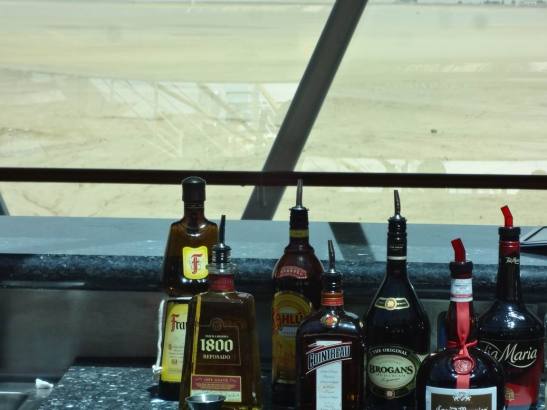 I think that every bus in Cochin (Kochi) had been hired for our arrival. This time we didn’t take a ship’s tour because it is just as easy to DIY.
I think that every bus in Cochin (Kochi) had been hired for our arrival. This time we didn’t take a ship’s tour because it is just as easy to DIY.
 Two of our friends had decided to join us for a tuk tuk tour of Cochin. Our other two friends where having no end of trouble with immigration, because my other friend’s wife who is Chinese had to be processed differently than the rest of us even though she had an Indian visa issued in New Zealand.
Two of our friends had decided to join us for a tuk tuk tour of Cochin. Our other two friends where having no end of trouble with immigration, because my other friend’s wife who is Chinese had to be processed differently than the rest of us even though she had an Indian visa issued in New Zealand.
We checked various tuk tuk drivers for their command of English and picked one who had a business card printed in English with a list of the main places to see.
I wanted an English speaking guide so there would not be any misunderstanding about the rate agreed, on our return to the ship.
 There isn’t a lot of room in a tuk tuk for two – make sure you are both close friends.
There isn’t a lot of room in a tuk tuk for two – make sure you are both close friends.
 It was monsoon season so I took precautions of carrying a pair of flips flops because I didn’t want my shoes ruined in water.
It was monsoon season so I took precautions of carrying a pair of flips flops because I didn’t want my shoes ruined in water.
 Follow that Ferrari !
Follow that Ferrari !

View from the back seat – these machines will turn on a sixpence.
 First call was the dhobi wallah – local laundry – one of them had the contract for all the bedding of a local hotel. The above picture is the main area where the ironing takes place.
First call was the dhobi wallah – local laundry – one of them had the contract for all the bedding of a local hotel. The above picture is the main area where the ironing takes place.
 This man was ironing a shirt – the iron was heated by red hot coals in the base of the iron – the whole ironing ‘item’ weighed eight kilos! (nearly 18 lbs). As we watched it looked as if part of the shirt was going to be marked with a burn but it wasn’t and he handled the heavy unit with great dexterity.
This man was ironing a shirt – the iron was heated by red hot coals in the base of the iron – the whole ironing ‘item’ weighed eight kilos! (nearly 18 lbs). As we watched it looked as if part of the shirt was going to be marked with a burn but it wasn’t and he handled the heavy unit with great dexterity.
We were told that the weight was 8 kilos so I checked on the empty weight (the iron is called a charcoal iron) and the empty weight is 2.75 kilos, but I doubt that it would hold 5 kilos of burning charcoal so perhaps they meant 8 pounds, regardless it was interesting to see him work.
 This man was belting the life out of a piece of clothing – his washing tub was behind him – solid concrete.
This man was belting the life out of a piece of clothing – his washing tub was behind him – solid concrete.
 All done by hand – washing tub at the back, soap powders, and a constant wet floor. If it is the same as Mumbai (Bombay) then each ‘cubical’ is an individual businessman rather than part of a larger company.
All done by hand – washing tub at the back, soap powders, and a constant wet floor. If it is the same as Mumbai (Bombay) then each ‘cubical’ is an individual businessman rather than part of a larger company.
 Even in the monsoon season people were optimistic enough to hang washing out. The washing was not held on the line with pegs – the washing line was made from twisted coconut fibre and a couple of lines were platted so that the clothes could be poked through the platted line and strung between the ‘A’ frame poles.
Even in the monsoon season people were optimistic enough to hang washing out. The washing was not held on the line with pegs – the washing line was made from twisted coconut fibre and a couple of lines were platted so that the clothes could be poked through the platted line and strung between the ‘A’ frame poles. Behind me is the garden where the clotheslines are located, to my left is the ironing room and on the right is the washing area where people in each cubical / section beat the dirt out of clothes – see below – I should have used a flash.
Behind me is the garden where the clotheslines are located, to my left is the ironing room and on the right is the washing area where people in each cubical / section beat the dirt out of clothes – see below – I should have used a flash.
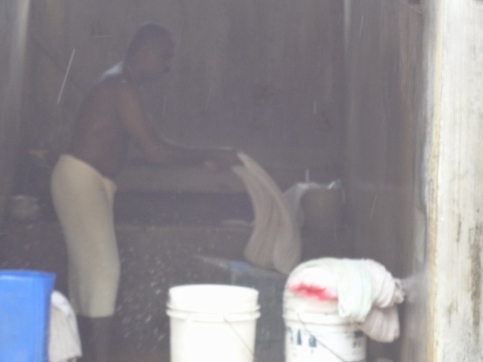
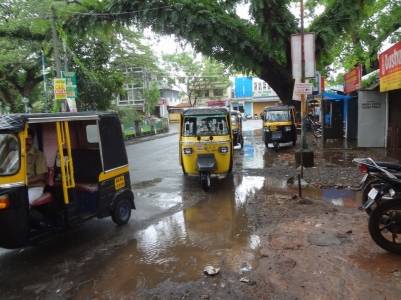 Flip flop time – it is still raining – I changed shoes after which I didn’t care whether my feet got wet or not.
Flip flop time – it is still raining – I changed shoes after which I didn’t care whether my feet got wet or not.
In our tuk tuk Maureen sat on the right & I was on the left. The right hand side had a heavy plastic sheet to keep the passenger dry from rain & spray of the traffic. The left hand side was the entry / exit point for the passengers so it didn’t have a plastic sheet, but our driver used his customer service skills and obtained an umbrella for me to hold open, while he drove, to try and stop the rain coming in to the cab area and wetting his passengers. I was always concerned that when it was up I couldn’t see what was ahead of us, or if I was going to belt a pedestrian or scratch a car / truck. ‘Elf & safety . . . . wots dat?
 Santa Cruz Cathedral Basilica.
Santa Cruz Cathedral Basilica.
Maureen & I and our friends were not in to sight seeing churches, temples or mosques, but at times a particular place of worship has strong historical link.
It was built by the Portuguese and became a Cathedral in 1558. When the Dutch arrived they destroyed many catholic churches, but not this one. When the British arrived in 1795 they demolished the old building (the church), because the Dutch had been using it as a store for their arms.
In 1887 a new building was started on the old site and this was consecrated in 1905, and Pope John Paul 11 proclaimed it a Basilica in 1984.
The day we visited I expected to see Noah gathering the animals because the rain was so heavy.

 Inside the church – I found the painting in the ceiling interesting, they depict the 12 stations of the cross.
Inside the church – I found the painting in the ceiling interesting, they depict the 12 stations of the cross.
 I’d been telling our friends of the Chinese fishing nets, and how unusual there are, but I should have warned them that not everything is as it should be – the above is from an advert.
I’d been telling our friends of the Chinese fishing nets, and how unusual there are, but I should have warned them that not everything is as it should be – the above is from an advert.
 I took the above in heavy rain while trying to keep my umbrella from blowing away. The rubbish on the beach devalued the whole image.
I took the above in heavy rain while trying to keep my umbrella from blowing away. The rubbish on the beach devalued the whole image.
 The stalls selling fresh fish were also a disappointment, due to lack of shoppers and the miserable weather.
The stalls selling fresh fish were also a disappointment, due to lack of shoppers and the miserable weather.
 St Francis was the first European church to be built in India, originally of wood and then of stone in about 1516. Being a church for the Portuguese it was catholic, until the Dutch arrived in 1663 when it was reconditioned and converted to a protestant church. It remained a Dutch church even after the British had captured Cochin in 1795. It was given, by the Dutch, to the British Anglican community in 1804.
St Francis was the first European church to be built in India, originally of wood and then of stone in about 1516. Being a church for the Portuguese it was catholic, until the Dutch arrived in 1663 when it was reconditioned and converted to a protestant church. It remained a Dutch church even after the British had captured Cochin in 1795. It was given, by the Dutch, to the British Anglican community in 1804.
Vasco de Gama, the famous Portuguese navigator, died in Cochin in 1524 and was laid to rest in this church. Fourteen years later in 1538, his remains were removed to Portugal and he was reburied in Lisbon.

For those interested in researching their family history this church has the Doop Book, which is a record of baptisms and weddings from 1751 to 1804. Many Dutch who are interested in their family history visit the church, because visitors are able to study the Doop Book records. The original book was sent to London in 1932 to be repaired by experts, and rebound in the original way. Due to the importance of the original book the copy available for research is a facsimile.
The Minister or Predikant of the church, Peter Cornelius kept the Doop Book up to date in his own hand writing for forty years.
The Church of South India, which has 22 dioceses across four States of southern India, and Sri Lanka, currently owns the St Francis Church in Cochin (Kochi). The church holds regular services each Sunday, and is open the other six days for tourists and visitors.
 Since the arrival in Cochin of the Portuguese the reason the trade began was due to spices, and it hasn’t changed in centuries.
Since the arrival in Cochin of the Portuguese the reason the trade began was due to spices, and it hasn’t changed in centuries.
 The latest trader was Maureen as she bargained for a bag of cinnamon – it was offered at USD $7, we offered $5 and they were happy. Considering the price in Sydney USD $5 was cheap, but the transport from Cochin to Sydney was free :-o)
The latest trader was Maureen as she bargained for a bag of cinnamon – it was offered at USD $7, we offered $5 and they were happy. Considering the price in Sydney USD $5 was cheap, but the transport from Cochin to Sydney was free :-o)
Australian quarantine checked the bag and its contents, before returning it to Maureen, and allowing it in to the country.
 The smell of the spices was pure magic – I did ask about the small brown seeds that can bee seen, but can not remember the answer.
The smell of the spices was pure magic – I did ask about the small brown seeds that can bee seen, but can not remember the answer.
 How about spices in liquid form.
How about spices in liquid form.
 or powder form – your choice.
or powder form – your choice.

The Jews in the early days had a lot to do with the trading.
 Jew – Town Road
Jew – Town Road
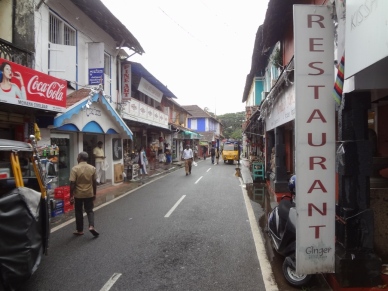 Interesting shops from jewellery to clothing to souvenirs and more colours than you can shake a stick at . . .
Interesting shops from jewellery to clothing to souvenirs and more colours than you can shake a stick at . . .
 Perhaps for the festival of Holi – which is The Festival of Colours – Lord Krishna is thought to have loved jokes and would drench girls in water and colour.
Perhaps for the festival of Holi – which is The Festival of Colours – Lord Krishna is thought to have loved jokes and would drench girls in water and colour.
 I obtained the above & below pictures off the net
I obtained the above & below pictures off the net
 The dhobi wallah must love this ceremony.
The dhobi wallah must love this ceremony.

We were never too far from spices
 Even elephants had to have a doze in the monsoons season.
Even elephants had to have a doze in the monsoons season.
Back to the ship for a late lunch and a dry wine – the only dry bit of the whole tour.


 Abu Dhabi 1963 during my first visit to this town. In the early 60’s going ashore was by a boat to a local beach.
Abu Dhabi 1963 during my first visit to this town. In the early 60’s going ashore was by a boat to a local beach. Dhows would come out to us, (after we’d anchored), and we would work cargo using our own derricks etc.
Dhows would come out to us, (after we’d anchored), and we would work cargo using our own derricks etc.
 I took the above as the Majestic Princess manoeuvred alongside – you can see the disturbed water from our side thrusters pushing us bodily alongside.
I took the above as the Majestic Princess manoeuvred alongside – you can see the disturbed water from our side thrusters pushing us bodily alongside. Doesn’t matter where we go we end up in a fish market . . . without chips.
Doesn’t matter where we go we end up in a fish market . . . without chips. I can’t remember what type of fish this chap was showing us, but I’m sure someone will tell me. I liked the colour and wondered if it retained its colour once it was cooked, and on the plate.
I can’t remember what type of fish this chap was showing us, but I’m sure someone will tell me. I liked the colour and wondered if it retained its colour once it was cooked, and on the plate. Presidential Palace
Presidential Palace Heritage village – I found it a disappointing place that had been ‘recreated’ and had little resemblance to the Abu Dhabi that I remembered.
Heritage village – I found it a disappointing place that had been ‘recreated’ and had little resemblance to the Abu Dhabi that I remembered. The above gives you an idea of what Abu Dhabi was like in the early 60’s. The shops didn’t sell post cards the last time I went shopping in Abu Dhabi, but Japanese electronics, which are now collectors items. The person with the umbrella is protecting themselves from the sun, not rain.
The above gives you an idea of what Abu Dhabi was like in the early 60’s. The shops didn’t sell post cards the last time I went shopping in Abu Dhabi, but Japanese electronics, which are now collectors items. The person with the umbrella is protecting themselves from the sun, not rain. Front area of the Presidential Palace.
Front area of the Presidential Palace. The guide did mention that each of the wives of the Sheik had their own entrance to the living quarters, so as not to meet each other I suppose.
The guide did mention that each of the wives of the Sheik had their own entrance to the living quarters, so as not to meet each other I suppose. I think this is the bridge to nowhere – a private island that is empty, so I suppose that makes this a private bridge . . . didn’t see any vehicles on the bridge.
I think this is the bridge to nowhere – a private island that is empty, so I suppose that makes this a private bridge . . . didn’t see any vehicles on the bridge. A short time after the ‘bridge to nowhere’ the Sheikh Zayed Mosque came in to view. According to what I have read in the ship’s blurb for the tour of Abu Dhabi, the mosque is the 8th largest mosque in the world, but according to the internet it is the 9th, but who’s counting? Enough to say that it is big.
A short time after the ‘bridge to nowhere’ the Sheikh Zayed Mosque came in to view. According to what I have read in the ship’s blurb for the tour of Abu Dhabi, the mosque is the 8th largest mosque in the world, but according to the internet it is the 9th, but who’s counting? Enough to say that it is big. Main entrance after security.
Main entrance after security. Area to the left of the main entrance with the pool.
Area to the left of the main entrance with the pool. The inner courtyard after passing through the main entrance of the mosque. A minaret is at each corner. The courtyard is 17,000 sq mtrs (180,000 sq feet).
The inner courtyard after passing through the main entrance of the mosque. A minaret is at each corner. The courtyard is 17,000 sq mtrs (180,000 sq feet). It is thought to be the largest example of marble mosaic in the world.
It is thought to be the largest example of marble mosaic in the world.
 The start of the walkway.
The start of the walkway. With the breeze blowing through it was not unpleasant walking along the columned passages.
With the breeze blowing through it was not unpleasant walking along the columned passages.

 The lady turned out to be Maureen – she’d been offered an abaya from our coach driver.
The lady turned out to be Maureen – she’d been offered an abaya from our coach driver.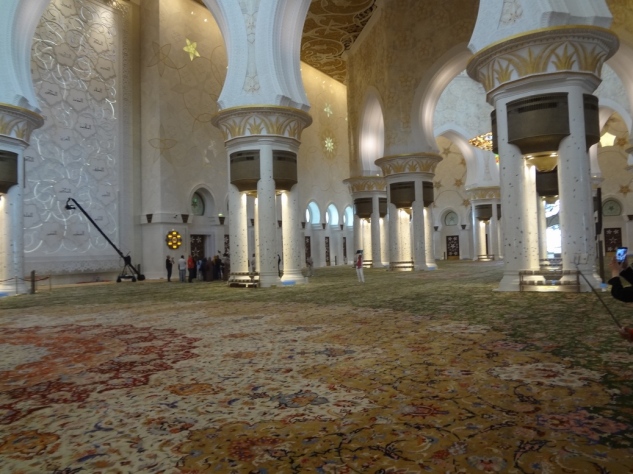 Once inside the main hall we could see the carpet – 5,627 sq mtrs (60,570 sq feet). The largest carpet in the world, at 35 tons, it took 1200 to 1300 carpet knotters around two years to tie 2,268,000 knots to create the carpet, which is mainly wool from New Zealand & Iran. Apparently some of the carpet is slightly higher than other parts. This is to help worshippers, when on their knees, to face the correct way. The direction indication of ‘correctness’ can not be seen when standing.
Once inside the main hall we could see the carpet – 5,627 sq mtrs (60,570 sq feet). The largest carpet in the world, at 35 tons, it took 1200 to 1300 carpet knotters around two years to tie 2,268,000 knots to create the carpet, which is mainly wool from New Zealand & Iran. Apparently some of the carpet is slightly higher than other parts. This is to help worshippers, when on their knees, to face the correct way. The direction indication of ‘correctness’ can not be seen when standing. There are seven chandeliers imported from Germany and they contain millions of Swarovski crystals.
There are seven chandeliers imported from Germany and they contain millions of Swarovski crystals.





 Abu Dhabi is expanding with the reclaiming of land from the Persian (Arabian) Gulf.
Abu Dhabi is expanding with the reclaiming of land from the Persian (Arabian) Gulf. New homes built on reclaimed land – they did look nice.
New homes built on reclaimed land – they did look nice. A friend of mine that I used to work with in BOAC in the 1970’s, heard that Maureen & I would be sailing in the Majestic Princess, and that she would be visiting Dubai for a day on the way to Singapore.
A friend of mine that I used to work with in BOAC in the 1970’s, heard that Maureen & I would be sailing in the Majestic Princess, and that she would be visiting Dubai for a day on the way to Singapore.
 For those who can remember BOAC :-o)
For those who can remember BOAC :-o)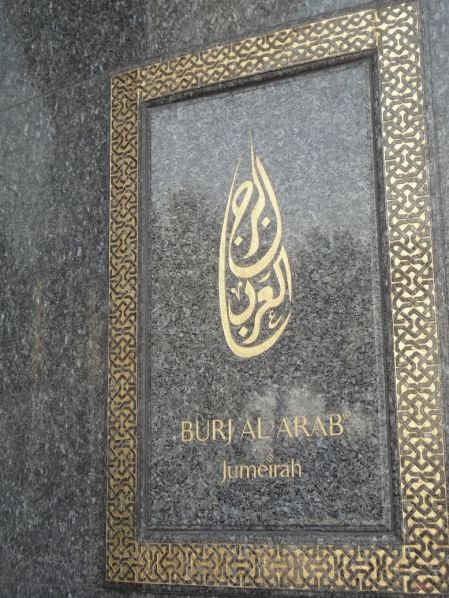

 I was able to read more about Lawrence of Arabia. The museum was cool (as in climate) and very interesting. I took a number of photos of various items on display, but for some reason only the above picture registered on the camera. At least the outside pictures worked.
I was able to read more about Lawrence of Arabia. The museum was cool (as in climate) and very interesting. I took a number of photos of various items on display, but for some reason only the above picture registered on the camera. At least the outside pictures worked.
 The main reception area where Leo introduced himself to the receptionist and a young lady came over to meet us and show us various areas of the hotel.
The main reception area where Leo introduced himself to the receptionist and a young lady came over to meet us and show us various areas of the hotel.
 There is another escalator & aquarium on the other side of the of the mini-fountains.
There is another escalator & aquarium on the other side of the of the mini-fountains. Different colours for various floors.
Different colours for various floors.
 Maureen & Leo walk quietly to the lift.
Maureen & Leo walk quietly to the lift.
 Walk through the tunnel to the restaurant. The colour gold is everywhere.
Walk through the tunnel to the restaurant. The colour gold is everywhere. We are in the Al Mahara restaurant and the whole wall is an aquarium – not sure if we are supposed to pick our fish for eating as it swims passed or do we just admire the view.
We are in the Al Mahara restaurant and the whole wall is an aquarium – not sure if we are supposed to pick our fish for eating as it swims passed or do we just admire the view.
 Private dining room – I am not sure if the aquarium at the end is part of the restaurant aquarium.
Private dining room – I am not sure if the aquarium at the end is part of the restaurant aquarium. The private dining room – view taken with my back to the aquarium.
The private dining room – view taken with my back to the aquarium.
 View of outside from the reception area.
View of outside from the reception area.
 Corridor to where, I don’t know.
Corridor to where, I don’t know. Looking down on to a tearoom come bar area and below the bar area is the main entrance.
Looking down on to a tearoom come bar area and below the bar area is the main entrance.

 The walk area towards ‘our’ suite.
The walk area towards ‘our’ suite. Entrance area of the suite – two floors, dining room, sitting room two double bedrooms each en-suite.
Entrance area of the suite – two floors, dining room, sitting room two double bedrooms each en-suite. Leo & our guide in the reception area of the suite.
Leo & our guide in the reception area of the suite. Leo felt quite at home, with his gold computer . . .
Leo felt quite at home, with his gold computer . . . Sitting room
Sitting room Dining room.
Dining room. General view back towards the reception area.
General view back towards the reception area.
 Main bedroom
Main bedroom En-suite bathroom.
En-suite bathroom. Dressing room for main bedroom.
Dressing room for main bedroom. Second bedroom
Second bedroom Second bedroom en-suite (also with dressing room)
Second bedroom en-suite (also with dressing room)

 View from the sitting room window. A little hazy due to sand in the air.
View from the sitting room window. A little hazy due to sand in the air.


 Mariner Bay Sands Hotel
Mariner Bay Sands Hotel As the Majestic Princess docked I took the above picture of a grand old lady alongside in Dubai – she has been in Dubai since 2008.
As the Majestic Princess docked I took the above picture of a grand old lady alongside in Dubai – she has been in Dubai since 2008.
 Quiet and peaceful and only at night does it come alive as a nightclub. The roof over the pool keeps the temperature steady, regardless of the outside temperature.
Quiet and peaceful and only at night does it come alive as a nightclub. The roof over the pool keeps the temperature steady, regardless of the outside temperature. In addition to the swimming pool there are hot tubs, and quiet spots over looking the ocean.
In addition to the swimming pool there are hot tubs, and quiet spots over looking the ocean. Peace & quiet
Peace & quiet There is also a bar, but most people just sat & read during the day.
There is also a bar, but most people just sat & read during the day.





 Or one could sit just outside to add to the suntan – waiter service for a cold beer, I didn’t want to break out in to a sweat after all . . .
Or one could sit just outside to add to the suntan – waiter service for a cold beer, I didn’t want to break out in to a sweat after all . . . For those who trusted the ‘see through’ floors (decks) on the Skywalk, you could watch the water flow under your feet. Your brain told you that it would be safe, but many still walked with one foot on each side of the reinforced glass area.
For those who trusted the ‘see through’ floors (decks) on the Skywalk, you could watch the water flow under your feet. Your brain told you that it would be safe, but many still walked with one foot on each side of the reinforced glass area.




 When we sailed close to the Indian coast, on our way to Cochin (Kochi), we experienced a heavy downpour, due to it being the monsoon season, which cleared everyone from the pool area.
When we sailed close to the Indian coast, on our way to Cochin (Kochi), we experienced a heavy downpour, due to it being the monsoon season, which cleared everyone from the pool area. Sunrise over Aqaba
Sunrise over Aqaba In the distance Israel, behind us Saudi Arabia, and further to the left of Israel is Egypt as we came alongside Aqaba.
In the distance Israel, behind us Saudi Arabia, and further to the left of Israel is Egypt as we came alongside Aqaba.
 Thomas Edward Lawrence, 1880 – 1935
Thomas Edward Lawrence, 1880 – 1935 It wasn’t long after we had driven out of Aqaba that we came across camels.
It wasn’t long after we had driven out of Aqaba that we came across camels. We stopped at a small railways station for a ‘photo op’ and the single line reminded me of the film, and when I turned around . . . the train engine fitted the scene, because it was used in the film.
We stopped at a small railways station for a ‘photo op’ and the single line reminded me of the film, and when I turned around . . . the train engine fitted the scene, because it was used in the film. if Peter O’Toole had stood on the roof of the train I wouldn’t have been surprised.
if Peter O’Toole had stood on the roof of the train I wouldn’t have been surprised.

 It was real, not a film set.
It was real, not a film set. The meeting area for our desert transport was more upmarket than the railway station, with a few shops and toilet facilities. The large rock face in the background is called the Seven Pillars, which was the inspirational name that Lawrence used when he wrote The Seven Pillars of Wisdom’.
The meeting area for our desert transport was more upmarket than the railway station, with a few shops and toilet facilities. The large rock face in the background is called the Seven Pillars, which was the inspirational name that Lawrence used when he wrote The Seven Pillars of Wisdom’. Nothing flash about our desert transport – the utes made the Aussie’s feel at home. I whispered to Maureen to grab one with a roof covering, how ever flimsy, to keep us in the shade. Each truck carried six passengers in the back – hanging on was the object of the trip once the truck started to move.
Nothing flash about our desert transport – the utes made the Aussie’s feel at home. I whispered to Maureen to grab one with a roof covering, how ever flimsy, to keep us in the shade. Each truck carried six passengers in the back – hanging on was the object of the trip once the truck started to move. If I’d have heard John Wayne shouting ‘Head ’em up move ’em out’ I wouldn’t have been surprised.
If I’d have heard John Wayne shouting ‘Head ’em up move ’em out’ I wouldn’t have been surprised.
 The scenery was spectacular as we bounced over the ground – they didn’t have any roads across the desert.
The scenery was spectacular as we bounced over the ground – they didn’t have any roads across the desert. We reached a sand hill and were told that if we climbed the hill the views would be magnificent.
We reached a sand hill and were told that if we climbed the hill the views would be magnificent. It didn’t look all that hard so I started to climb, Maureen stayed with the trucks.
It didn’t look all that hard so I started to climb, Maureen stayed with the trucks. In the very soft sand each foot step was energy sapping – and my new pacemaker started to work overtime.
In the very soft sand each foot step was energy sapping – and my new pacemaker started to work overtime. Nearing the top – gasp, gasp, keep pumping . . .
Nearing the top – gasp, gasp, keep pumping . . . Made it ! and the driver was correct the views were just great.
Made it ! and the driver was correct the views were just great. Looking back to our convoy of trucks.
Looking back to our convoy of trucks. I tried to capture the distances and the depth of beauty – the isolation, the quiet and as Lawrence himself said, the desert is clean.
I tried to capture the distances and the depth of beauty – the isolation, the quiet and as Lawrence himself said, the desert is clean. Off again until we came to a camp with camels. The offer being USD $15 per person to ride a camel to the next stop (about twenty minutes by camel). Quiet a few took them up on the camel owner’s offer.
Off again until we came to a camp with camels. The offer being USD $15 per person to ride a camel to the next stop (about twenty minutes by camel). Quiet a few took them up on the camel owner’s offer. The rest of us climbed back in to our trucks for a more ‘comfortable’ ride.
The rest of us climbed back in to our trucks for a more ‘comfortable’ ride.
 A cup of tea at a Bedouin camp – as you see the latest addition to the Bedouin camel is blue (on the right of the picture).
A cup of tea at a Bedouin camp – as you see the latest addition to the Bedouin camel is blue (on the right of the picture). Small glasses of tea were offered – brewed using the open fire. Cardamom seeds were added to the drink after it had been brewed. The seed gave the drink a distinctive taste which was not unpleasant. Of course they had various articles for sale.
Small glasses of tea were offered – brewed using the open fire. Cardamom seeds were added to the drink after it had been brewed. The seed gave the drink a distinctive taste which was not unpleasant. Of course they had various articles for sale. Outside carved in to a rock was a sculpture of the King of Jordon and also Lawrence.
Outside carved in to a rock was a sculpture of the King of Jordon and also Lawrence. I don’t think the artist had seen Lawrence . . .
I don’t think the artist had seen Lawrence . . . The rest of our group arrived safely and the camel handler started back for the next load of tourists.
The rest of our group arrived safely and the camel handler started back for the next load of tourists. Back on the flat ground again and we suddenly came to a tent hotel – welcome, cold drinks, tea, biscuits, and local music.
Back on the flat ground again and we suddenly came to a tent hotel – welcome, cold drinks, tea, biscuits, and local music. Dining area
Dining area
 Background Arabic music.
Background Arabic music.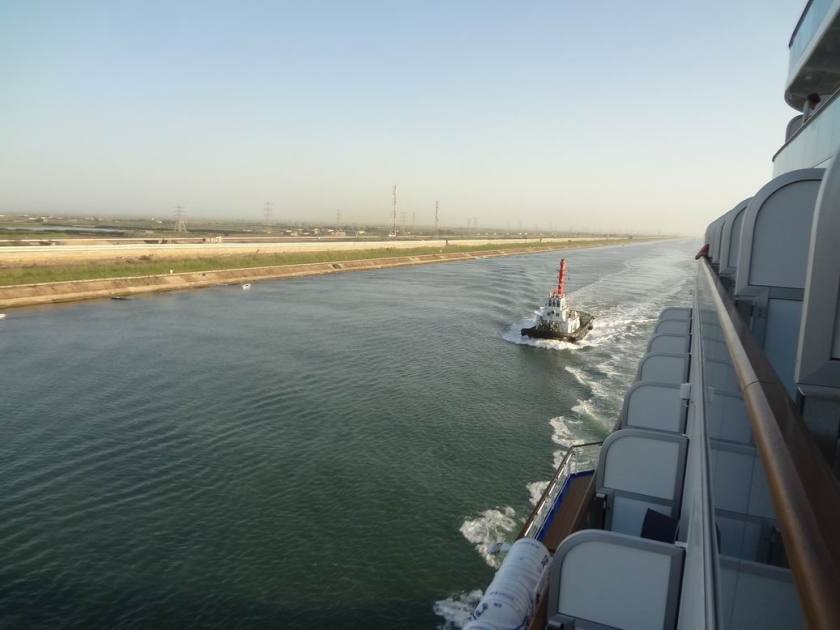

 as guest of honour on board, to be the first vessel to transit the canal.
as guest of honour on board, to be the first vessel to transit the canal.

 The picture shows her later in her life.
The picture shows her later in her life.







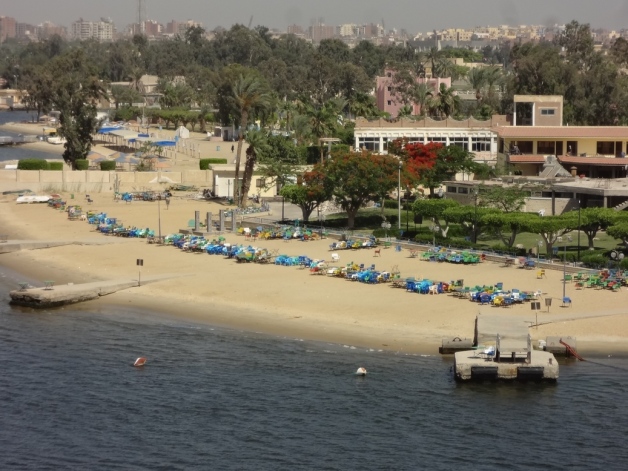 Beach front of the Mecure Hotel
Beach front of the Mecure Hotel I saw the above blue building in the distance, but have not be able to find out what it is . . .
I saw the above blue building in the distance, but have not be able to find out what it is . . . On our port side a striking difference to the holiday feel of Timsah Lake.
On our port side a striking difference to the holiday feel of Timsah Lake.




 During the Six Day War in 1967 the canal was closed and fifteen ships were locked in the Bitter Lakes. They became known as the Yellow Fleet because of the sand blown from the desert that covered their decks in yellow sand. The crews cooperated with each other and created their own post office and stamp. The Yellow Fleet stamps have become a collector’s item. The canal didn’t reopen until 1975.
During the Six Day War in 1967 the canal was closed and fifteen ships were locked in the Bitter Lakes. They became known as the Yellow Fleet because of the sand blown from the desert that covered their decks in yellow sand. The crews cooperated with each other and created their own post office and stamp. The Yellow Fleet stamps have become a collector’s item. The canal didn’t reopen until 1975.

 More and more sand on the port side . . . .
More and more sand on the port side . . . .
 The queue for the ferry went for quite a long way.
The queue for the ferry went for quite a long way.



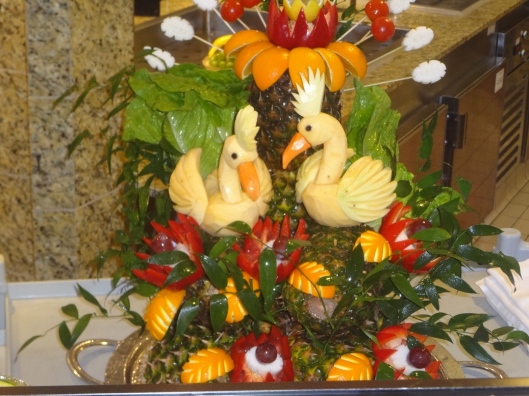


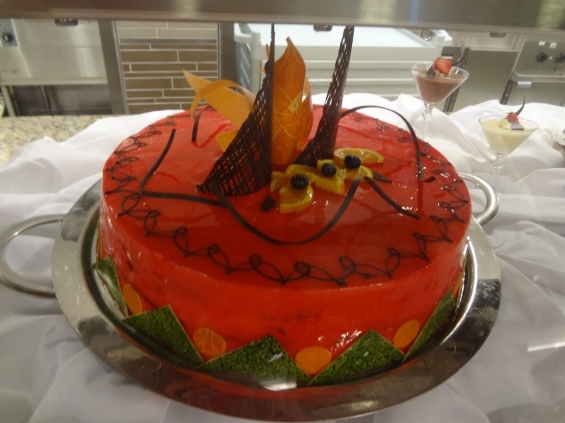


 A fresh lot of cakes came out . . . along with
A fresh lot of cakes came out . . . along with Chocolate fountain.
Chocolate fountain.





 The ship also carried Newcastle Brown ale on tap . . . a well balanced meal is a glass in each hand – Boddington & Newcastle ale.
The ship also carried Newcastle Brown ale on tap . . . a well balanced meal is a glass in each hand – Boddington & Newcastle ale.










